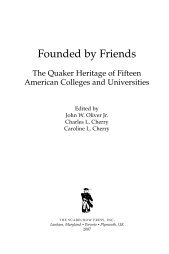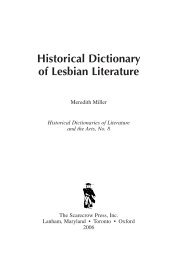Separate Realities: The Dream and the Iceberg - Scarecrow Press
Separate Realities: The Dream and the Iceberg - Scarecrow Press
Separate Realities: The Dream and the Iceberg - Scarecrow Press
You also want an ePaper? Increase the reach of your titles
YUMPU automatically turns print PDFs into web optimized ePapers that Google loves.
CLASS ISSUES IN THE MEDIA: THE AMERICAN DREAM (continued)<br />
Reality-based television programming offers a different, but no less compelling,<br />
kind of “proof” that <strong>the</strong> American <strong>Dream</strong> is alive <strong>and</strong> available to ordinary people.<br />
Popular TV reality programs in <strong>the</strong> latter 2000s, such as American Idol, Survivor, <strong>and</strong><br />
<strong>The</strong> Apprentice, elevate “winners” into Cinderella-like celebrities who appear to attain<br />
(at least for awhile) levels of economic success associated with <strong>the</strong> American<br />
<strong>Dream</strong>. In some respects, celebrity showcase reports, as well as reality TV programs,<br />
can be viewed as contemporary versions (with better production values <strong>and</strong> with real,<br />
ra<strong>the</strong>r than fictional, characters) of Horatio Alger Jr.’s popular “rags-to-riches” novels<br />
of <strong>the</strong> late nineteenth <strong>and</strong> early twentieth centuries (before <strong>the</strong> term American <strong>Dream</strong><br />
was coined). 5 Today, as in <strong>the</strong> past, <strong>the</strong> U.S. popular media message is twofold: first,<br />
<strong>the</strong> American <strong>Dream</strong> is widely attainable; second, those who have achieved <strong>the</strong><br />
dream—at spectacular levels—deserve not only <strong>the</strong>ir success, but also fawning media<br />
attention, public applause, <strong>and</strong> popular fascination.<br />
Partly as a result of <strong>the</strong> mainstream media’s framing of <strong>the</strong> American <strong>Dream</strong> as a<br />
reality that can readily lead to riches, this view appears to be firmly embedded in U.S.<br />
culture. 6 <strong>The</strong> media-driven popular faith in <strong>the</strong> dream-wealth linkage leads many<br />
Americans (especially <strong>the</strong> young) to view <strong>the</strong>mselves not as part of <strong>the</strong> working class<br />
or even <strong>the</strong> middle class but as members of what might be called <strong>the</strong> “prerich class.”<br />
To illustrate, a recent poll found that nearly 25 percent of U.S. teenagers believe <strong>the</strong>y<br />
will have $1 million in assets by age forty, <strong>and</strong> 15 percent think <strong>the</strong>y will earn more<br />
than $1 million annually. 7 For believers encouraged by “rags-to-riches” media reports,<br />
<strong>the</strong> American <strong>Dream</strong> means <strong>the</strong>y are certain to make <strong>the</strong> transition to <strong>the</strong> “actually<br />
rich class” in <strong>the</strong> not-too-distant future. With such a mind-set, it is not difficult<br />
to imagine that believers in <strong>the</strong> dream may also entertain <strong>the</strong> fantasy that when <strong>the</strong>y<br />
succeed, perhaps Oprah will ask <strong>the</strong>m to appear on her show <strong>and</strong> share <strong>the</strong>ir success<br />
stories with her (<strong>and</strong> her audience).<br />
NOTES<br />
1. <strong>The</strong> Oprah Winfrey Show, “What Class Are You? Inside America’s Taboo Topic,” on August 24,<br />
2006, <strong>the</strong> Internet at http://www.oprah.com/tows/pastshows/200604/tows_past_20060421.jhtml (visited<br />
May 13, 2006).<br />
2. <strong>The</strong> figure cited refers to <strong>the</strong> average annual number of U.S. newspaper articles with “American<br />
<strong>Dream</strong>” found in headline titles <strong>and</strong> lead paragraphs in <strong>the</strong> 2000–2006 period. It is based on <strong>the</strong> authors’<br />
analysis, using appropriate search parameters, of U.S. newspapers indexed in <strong>the</strong> Lexis-Nexis data<br />
base <strong>and</strong> published during this period.<br />
3. Wessel, “As Rich-Poor Gap Widens in <strong>the</strong> U.S., Class Mobility Stalls.”<br />
4. Barbara Ehrenreich, Bait <strong>and</strong> Switch: <strong>The</strong> (Futile) Pursuit of <strong>the</strong> American <strong>Dream</strong> (New York: Metropolitan,<br />
2005).<br />
5. Richard L. Zweigenhaft, “Making Rags out of Riches,” Extra! (January–February 2004): 27–28;<br />
Zweigenhaft <strong>and</strong> Domhoff, Diversity in <strong>the</strong> Power Elite, 3.<br />
6. National League of Cities, “<strong>The</strong> American <strong>Dream</strong> in 2004”; Center for a New American <strong>Dream</strong>,<br />
“New American <strong>Dream</strong> Survey Report,” New York Times, Class Matters, 6.<br />
7. Mark Maier, “High-School Economics: Corporate Sponsorship <strong>and</strong> Pro-Market Bias,” Dollars <strong>and</strong><br />
Sense (May–June 2002): 15.
















